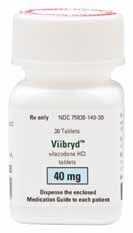Publication
Article
Pharmacy Times
Forest Laboratories' Viibryd
The FDA approved Viibryd (vilazodone hydrochloride) for the treatment of major depressive disorder.

Forest Laboratories’ Viibryd
On January 21, 2011, the FDA approved Viibryd (vilazodone hydrochloride) from Forest Laboratories to treat major depressive disorder. Vilazodone has shown no sexual side effects, unlike other antidepressants.2 Vilazodone has shown a decrease in time to the onset of antidepressant effects when compared with selective serotonin reuptake inhibitors (SSRIs).2
Pharmacology/ Pharmacokinetics
Vilazodone is the first in a new class of antidepressants named the indolealkylamines.2 The indolealkylamines combine the properties of SSRIs and 5-hydroxytryptamine-1A (5-HT1A) partial agonists. The mechanism of action of vilazodone is not fully understood. It is thought to be related to the enhancement of serotonergic activity in the central nervous system through selective inhibition of serotonin reuptake. Vilazodone also has partial agonist activity at the serotonergic 5-HT1A receptors.
Dosing and Administration
The recommended dose of vilazodone is 40 mg once daily. The titration schedule of vilazodone is 10 mg daily for 1 week and then doubling the dose weekly until 40 mg daily is reached.
Vilazodone should be taken with food. Taking vilazodone without food can result in lower absorption and may decrease its effectiveness.3
No dose adjustments are necessary in patients with mild, moderate, or severe renal impairment or in patients with mild to moderate hepatic impairment. 3 Vilazodone has not been studied in patients with severe hepatic impairment.3
Clinical Trials
The approval of Viibryd was based on 2 double-blinded, placebo-controlled, multicenter, 8-week trials which included 3 study periods: washout, screening, and an 8-week, double-blinded treatment period.2,4 Patients were randomized to receive vilazodone 40 mg daily or placebo. Subjects taking vilazodone started with 10 mg daily and were titrated up to 40 mg daily.
Vilazodone showed statistically significant improvement versus placebo in all 5 assessments in both studies. The most common adverse reactions in clinical trials were diarrhea, nausea, and headache.2,4 Using Arizona Sexual Experience Scale scores, there was a slight improvement in sexual function in men and women.2
Precautions/ Contraindications
Vilazodone carries a black box warning regarding antidepressant use and the increased risk of suicidal thinking and behavior in children, adolescents, and young adults, as shown in short-term studies of major depressive disorder. Vilazodone is not approved for use in pediatric patients.3
All patients being treated with antidepressants should be monitored and observed closely for clinical worsening, suicidality, and unusual changes in behavior, especially during the initial months of drug therapy and dose changes.
Concomitant use of vilazodone with monoamine oxidase inhibitors (MAOIs) for the treatment of depression is contraindicated due to the risk of serotonin syndrome. Concomitant use of vilazodone with serotonin precursors is also not recommended. Treatment with vilazodone and any concomitant serotonergic or antidopaminergic drugs should be discontinued immediately if symptoms of serotonin syndrome emerge. Because vilazodone has not been systematically evaluated in patients with seizure disorders, it should be prescribed with caution in these patients.
Drugs that interact with serotonin reuptake inhibition may increase the risk of bleeding events. Patients should be cautioned about the risk of bleeding with concomitant use of vilazodone and nonsteroidal anti-inflammatory drugs or other drugs that affect bleeding. Vilazodone should be used cautiously in patients with a history of bipolar disorder, mania, or hypomania.
Hyponatremia has occurred as a result of treatment with SSRIs and serotonin and norepinephrine reuptake inhibitors. Vilazodone should be discontinued in patients with symptomatic hyponatremia and appropriate medical intervention should be instituted. No cases of hyponatremia were reported in clinical studies.
Adverse events have occurred after discontinuation of serotonergic antidepressants, particularly when discontinuation is sudden. Adverse events include dysphoric mood, irritability, dizziness, sensory disturbances, lethargy, insomnia, hypomania, tinnitus, and seizures. Discontinuation should occur slowing by gradually decreasing the dosage whenever possible.
Drug Interactions
Adverse reactions, some of which are serious or fatal, can develop in patients who use MAOIs or have been recently discontinued from an MAOI and started on an antidepressant with pharmacologic properties similar to vilazodone. Vilazodone should not be prescribed concomitantly with an MAOI or within 14 days of discontinuing an MAOI.
Cytochrome P450 (CYP) 3A4 is a major elimination pathway for vilazodone. Use of CYP3A4 inhibitors can increase vilazodone plasma concentrations by 50%. The vilazodone dose should be reduced to 20 mg when the patient is also using a strong CPY3A4 inhibitor. Dose adjustment for patients taking moderate CYP3A4 inhibitors includes a dose reduction to 20 mg if the patient is experiencing intolerable adverse events. No dose adjustment is recommended for patients also taking mild CYP3A4 inhibitors.
Dr. Thomas is a clinical pharmacist, primary care in the Harris County Hospital District at Gulfgate Health Center in Houston, Texas. Ms. Gessner is a PharmD candidate at the University of Houston College of Pharmacy.
References
1. FDA approves Viibryd to treat major depressive disorder. FDA News Release. January 21, 2011.
2. Rickels K, Athanasiou M, Robinson DS, Gibertini M, Whalen H, Reed CR. Evidence for efficacy and tolerability of vilazodone in the treatment of major depressive disorder: a randomized, double-blind, placebo-controlled trial. J Clin Psychiatry. 2009;70(3):326-333.
3. Viibryd [product information]. New Haven, CT: Trovis Pharmaceuticals LLC; January 2011.
4. Khan A, Cutler AJ, Kajdasz DK, et al. Efficacy and tolerability of vilazodone, a dual-acting serotonergic antidepressant, in the treatment of patients with major depressive disorder (MDD). Poster presented at American Psychiatric Association, May 22-26, 2010, New Orleans, LA.







